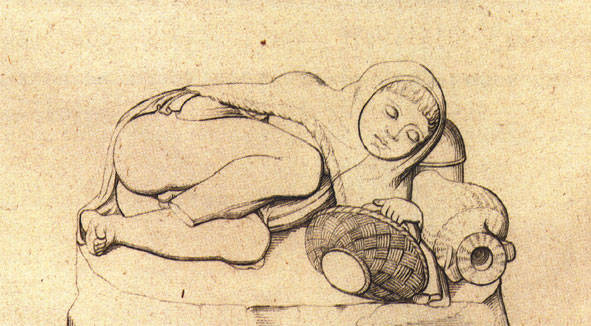Ancient Roman Slave Cemetery Found at Ostia Antica
ROME - The little community of slaves laboring at the port at Ancient Ostia, at the mouth of the Tiber River, was desperately poor, but when the eight-year-old boy died, they endowed his tomb with a delicate necklace of tiny seashells and worked beads of bone and imported amber. The boy’s skeleton marked him as the youngest of the 270 individuals buried in what Italian archaeologists are hailing as a unique, 2000-year-old port-side slave cemetery which covered 3,000 sq. m.
The skeletons themselves and the poverty of the burials testify that this was a slave cemetery. Seventy-two percent were males, mostly between the ages of twenty and forty, whereas in another urban cemetery, fully half the skeletons were of women. Forensic scientists say that numerous skeletons were deformed and bent from extremely heavy fatigue. Fractured limbs and numerous lesions in the vertebrae, as if from carrying hod, were common. Two-thirds of the bodies had been wrapped in a tight shroud and the sepulcher topped with wood planks or with two or three of the large flat roof tiles common in early Christian catacombs. The dead were placed flat on the back with the exceptions of one found lying face down and two who had been cremated.
The modest necklace found with the boy was the most opulent of the objects found in the tombs. Only one out of three had a symbolic tomb dowry, such as a coin in the mouth to help the dead on the voyage to the nether world.
“These poor bones will help us to learn more about life in the little community of workers in the capital of the Empire, when Rome at its peak between the First and Second Centuries AD,” Angelo Bottini, 59, superintendent of archaeology for Rome, told a press conference here June 9.
One aspect still being studied is the skull of a man around thirty who suffered from a rare disease that blocks the jaw. To help him to eat, his fellow slaves removed two of his teeth, an action which the Roman archaeologists working the site say would never have been performed by a slave owner. “Here we are seeing a poor community that did what it could to save the life of another person, permitting him to eat and to breathe again,” said Professor Bottini.
The workmen were presumably employed at the salt works near the mouth of the Tiber, in loading and unloading boats, and in the reconstruction of the port itself, under the emperors Claudius and Trajan.
The finding of the cemetery at Ponte Galeria came about thanks to some slick detective work. In a raid at the home of a suspected tomb robber, Finance Guards (fiscal police) headed by Capt. Marco La Malfa found a funeral lamp. The lamp led to a cache of other objects looted from the site and then to the site itself. The year-long excavation was completed this month, and the cemetery will be reburied shortly.
Population figures for antiquity are difficult, but it is estimated that at that time Rome had over one million inhabitants. Normally the slave population is calculated at 10% of the total, according to archaeologists attending a symposium on slavery in antiquity held at the British School in Rome.


































i-Italy
Facebook
Google+
This work may not be reproduced, in whole or in part, without prior written permission.
Questo lavoro non può essere riprodotto, in tutto o in parte, senza permesso scritto.